Abstract
The aim of the present study was to localize the dopamine receptors involved in the regulation of muscle tone. A strategy was used whereby the effects on muscle tone of injecting the irreversible dopamine receptor antagonist N-ethoxycarbonyl-2-ethoxy-1,2-dihydroquinoline (EEDQ) in discrete brain regions were assessed. Increases in muscle tone were measured as changes in electromyographic activity of the gastrocnemius and tibialis muscles of conscious, unrestrained rats. No increases in muscle tone were found after injections of EEDQ into the anterior and posterior striatum, which produced marked reductions in dopamine receptor concentration. The effects of muscle tone of injecting EEDQ into the substantia nigra pars reticulata were also assessed. Large increases in muscle tone were observed associated with inactivation of either D1 or D2 dopamine receptors in the substantia nigra. The increased muscle tone was not reduced by subcutaneous administration of apomorphine, despite the presence of a normal population of striatal dopamine receptors. These findings provide evidence that dopamine receptors in the substantia nigra play an important role in the regulation of muscle tone. Further, they challenge the hypothesis that the muscle rigidity of Parkinson disease results primarily from loss of striatal dopamine receptor stimulation.
Full text
PDF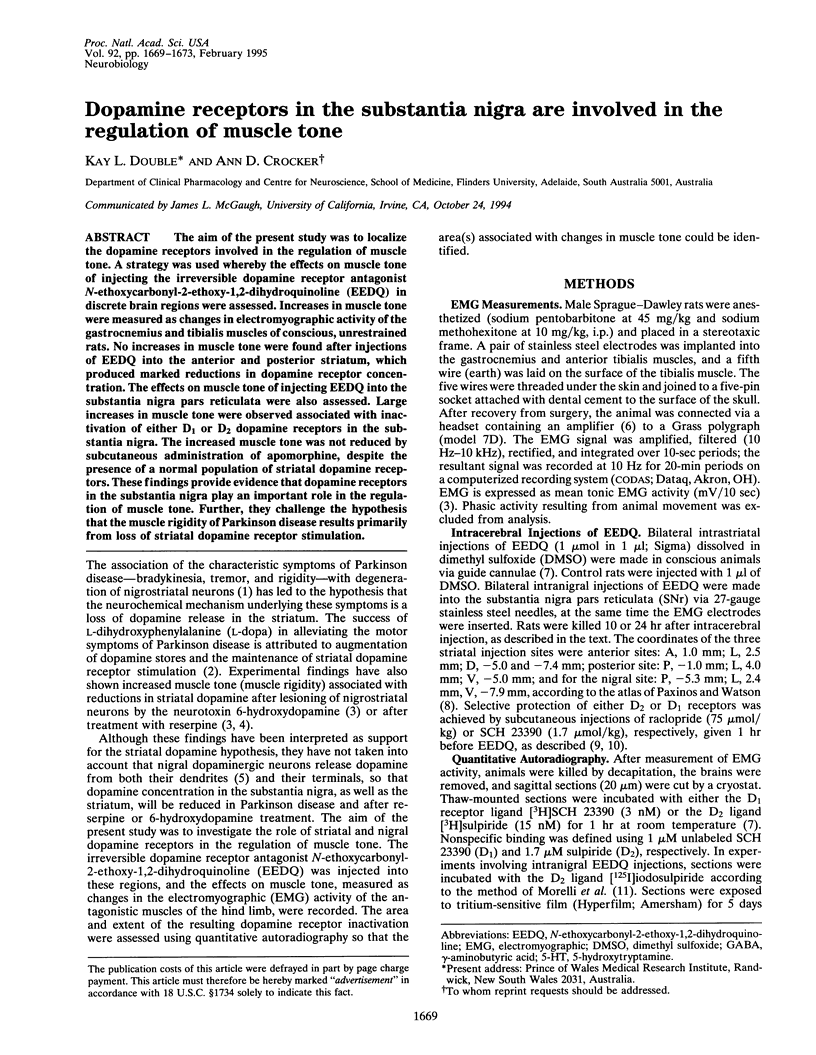
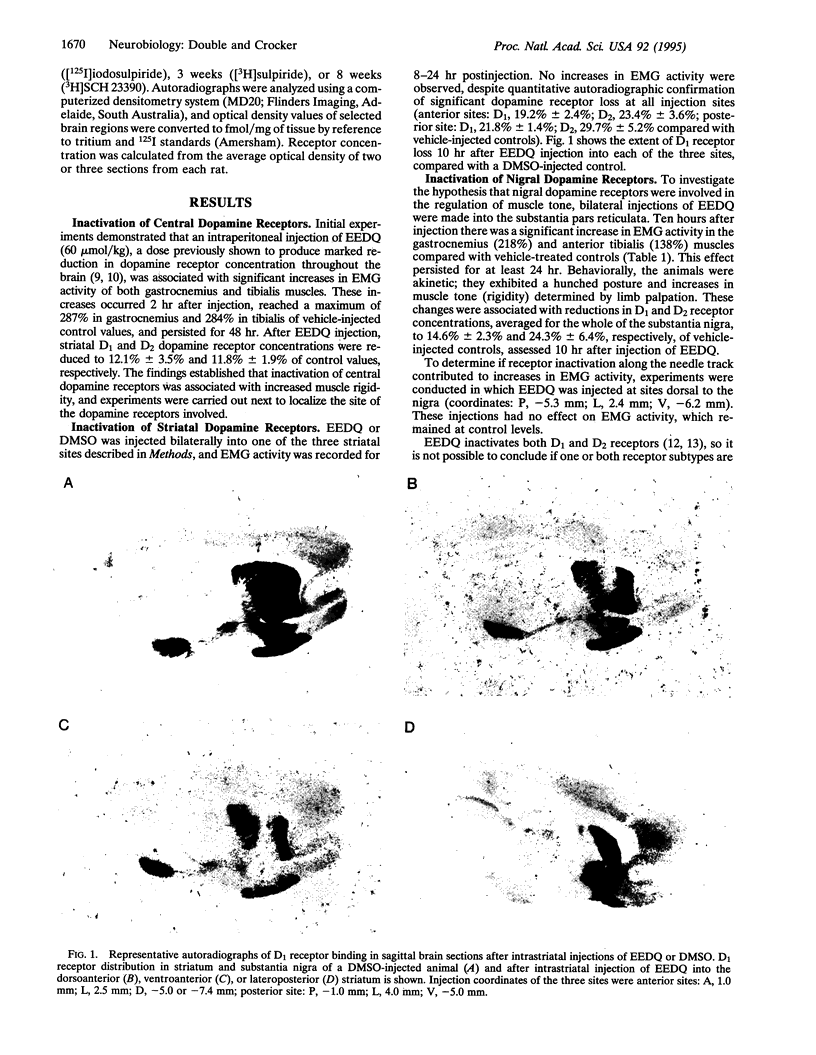
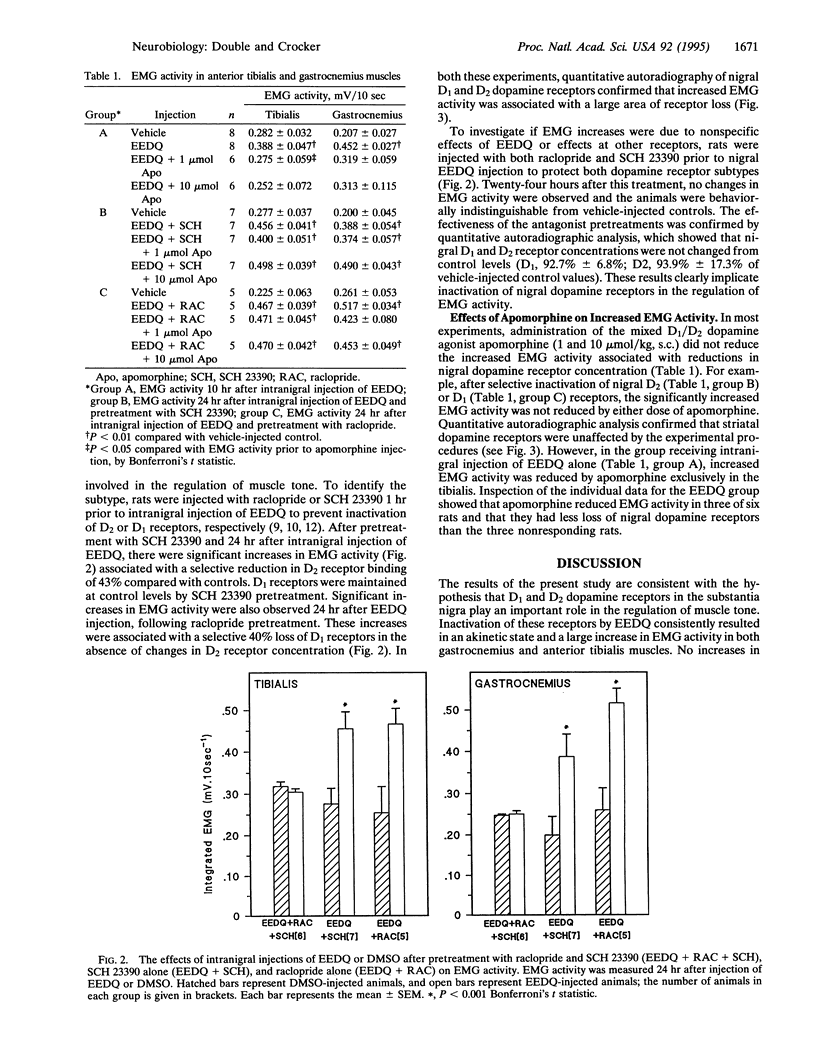
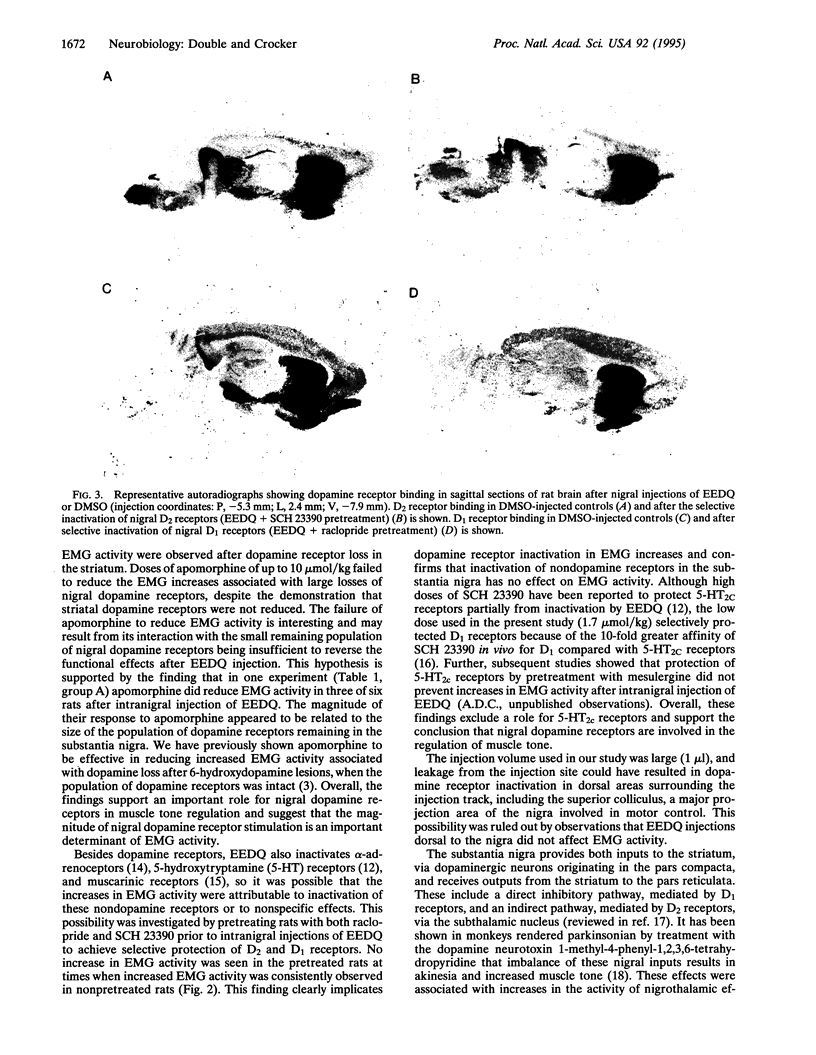
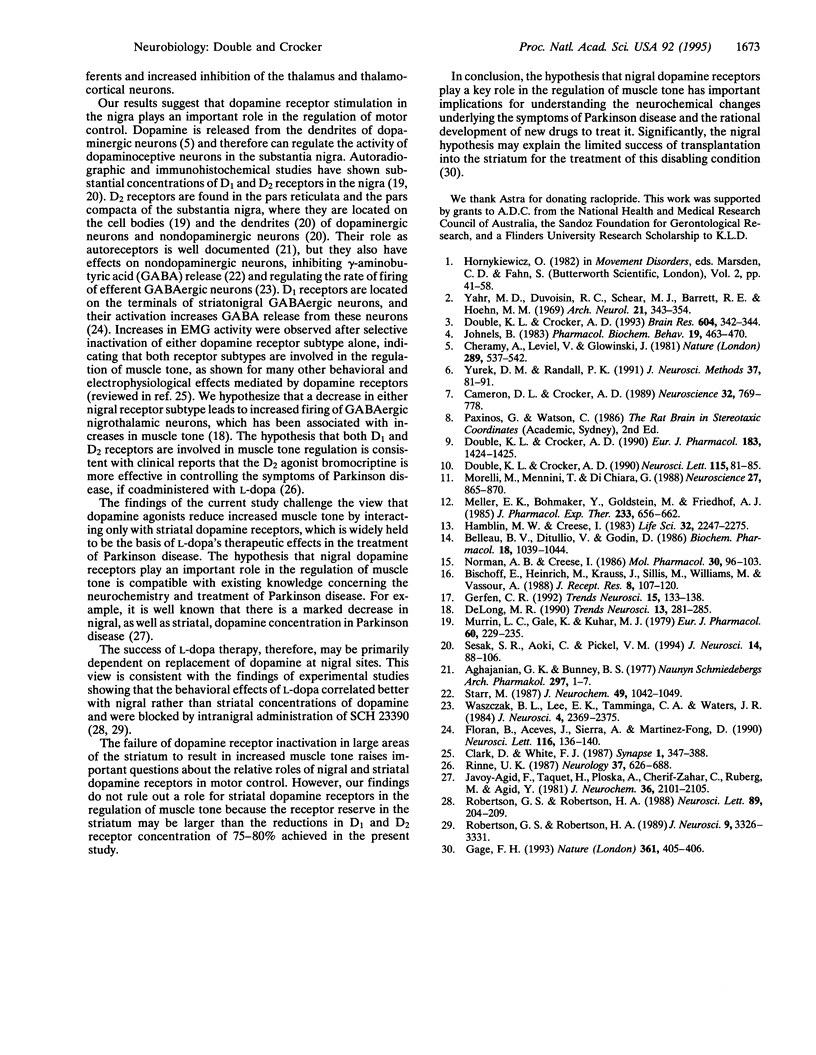
Images in this article
Selected References
These references are in PubMed. This may not be the complete list of references from this article.
- Aghajanian G. K., Bunney B. S. Dopamine"autoreceptors": pharmacological characterization by microiontophoretic single cell recording studies. Naunyn Schmiedebergs Arch Pharmacol. 1977 Mar;297(1):1–7. doi: 10.1007/BF00508803. [DOI] [PubMed] [Google Scholar]
- Belleau B., DiTullio V., Godin D. The mechanism of irreversible adrenergic blockade by N-carbethoxydihydroquinolines--model studies with typical serine hydrolases. Biochem Pharmacol. 1969 May;18(5):1039–1044. doi: 10.1016/0006-2952(69)90107-5. [DOI] [PubMed] [Google Scholar]
- Bischoff S., Heinrich M., Krauss J., Sills M. A., Williams M., Vassout A. Interaction of the D1 receptor antagonist SCH 23390 with the central 5-HT system: radioligand binding studies, measurements of biochemical parameters and effects on L-5-HTP syndrome. J Recept Res. 1988;8(1-4):107–120. doi: 10.3109/10799898809048981. [DOI] [PubMed] [Google Scholar]
- Cameron D. L., Crocker A. D. Localization of striatal dopamine receptor function by central injection of an irreversible receptor antagonist. Neuroscience. 1989;32(3):769–778. doi: 10.1016/0306-4522(89)90297-2. [DOI] [PubMed] [Google Scholar]
- Cheramy A., Leviel V., Glowinski J. Dendritic release of dopamine in the substantia nigra. Nature. 1981 Feb 12;289(5798):537–542. doi: 10.1038/289537a0. [DOI] [PubMed] [Google Scholar]
- Clark D., White F. J. D1 dopamine receptor--the search for a function: a critical evaluation of the D1/D2 dopamine receptor classification and its functional implications. Synapse. 1987;1(4):347–388. doi: 10.1002/syn.890010408. [DOI] [PubMed] [Google Scholar]
- DeLong M. R. Primate models of movement disorders of basal ganglia origin. Trends Neurosci. 1990 Jul;13(7):281–285. doi: 10.1016/0166-2236(90)90110-v. [DOI] [PubMed] [Google Scholar]
- Double K. L., Crocker A. D. Effects of inactivation of D1 dopamine receptors on stereotypic and thermic responses to quinpirole (LY 171555). Neurosci Lett. 1990 Jul 17;115(1):81–85. doi: 10.1016/0304-3940(90)90521-a. [DOI] [PubMed] [Google Scholar]
- Double K. L., Crocker A. D. Quantitative electromyographic changes following modification of central dopaminergic transmission. Brain Res. 1993 Feb 26;604(1-2):342–344. doi: 10.1016/0006-8993(93)90388-4. [DOI] [PubMed] [Google Scholar]
- Floran B., Aceves J., Sierra A., Martinez-Fong D. Activation of D1 dopamine receptors stimulates the release of GABA in the basal ganglia of the rat. Neurosci Lett. 1990 Aug 14;116(1-2):136–140. doi: 10.1016/0304-3940(90)90399-t. [DOI] [PubMed] [Google Scholar]
- Gage F. H. Parkinson's disease. Fetal implants put to the test. Nature. 1993 Feb 4;361(6411):405–406. doi: 10.1038/361405a0. [DOI] [PubMed] [Google Scholar]
- Gerfen C. R. The neostriatal mosaic: multiple levels of compartmental organization. Trends Neurosci. 1992 Apr;15(4):133–139. doi: 10.1016/0166-2236(92)90355-c. [DOI] [PubMed] [Google Scholar]
- Hamblin M. W., Creese I. Behavioral and radioligand binding evidence for irreversible dopamine receptor blockade by N-ethoxycarbonyl-2-ethoxy-1,2-dihydroquinoline. Life Sci. 1983 May 9;32(19):2247–2255. doi: 10.1016/0024-3205(83)90423-x. [DOI] [PubMed] [Google Scholar]
- Javoy-Agid F., Taquet H., Ploska A., Cherif-Zahar C., Ruberg M., Agid Y. Distribution of catecholamines in the ventral mesencephalon of human brain, with special reference to Parkinson's disease. J Neurochem. 1981 Jun;36(6):2101–2105. doi: 10.1111/j.1471-4159.1981.tb10843.x. [DOI] [PubMed] [Google Scholar]
- Johnels B. Reserpine-induced rigidity in rats: drug effects on muscle tone from corpus striatum and nucleus accumbens. Pharmacol Biochem Behav. 1983 Sep;19(3):463–470. doi: 10.1016/0091-3057(83)90121-1. [DOI] [PubMed] [Google Scholar]
- Meller E., Bohmaker K., Goldstein M., Friedhoff A. J. Inactivation of D1 and D2 dopamine receptors by N-ethoxycarbonyl-2-ethoxy-1,2-dihydroquinoline in vivo: selective protection by neuroleptics. J Pharmacol Exp Ther. 1985 Jun;233(3):656–662. [PubMed] [Google Scholar]
- Morelli M., Mennini T., Di Chiara G. Nigral dopamine autoreceptors are exclusively of the D2 type: quantitative autoradiography of [125I]iodosulpride and [125I]SCH 23982 in adjacent brain sections. Neuroscience. 1988 Dec;27(3):865–870. doi: 10.1016/0306-4522(88)90189-3. [DOI] [PubMed] [Google Scholar]
- Murrin L. C., Gale K., Kuhar M. J. Autoradiographic localization of neuroleptic and dopamine receptors in the caudate-putamen and substantia nigra: effects of lesions. Eur J Pharmacol. 1979 Dec 7;60(2-3):229–235. doi: 10.1016/0014-2999(79)90222-x. [DOI] [PubMed] [Google Scholar]
- Norman A. B., Creese I. Effects of in vivo and in vitro treatments with N-ethoxycarbonyl-2-ethoxy-1,2-dihydroquinoline on putative muscarinic receptor subtypes in rat brain. Mol Pharmacol. 1986 Aug;30(2):96–103. [PubMed] [Google Scholar]
- Robertson G. S., Robertson H. A. Evidence that L-dopa-induced rotational behavior is dependent on both striatal and nigral mechanisms. J Neurosci. 1989 Sep;9(9):3326–3331. doi: 10.1523/JNEUROSCI.09-09-03326.1989. [DOI] [PMC free article] [PubMed] [Google Scholar]
- Robertson G. S., Robertson H. A. Evidence that the substantia nigra is a site of action for L-DOPA. Neurosci Lett. 1988 Jun 29;89(2):204–208. doi: 10.1016/0304-3940(88)90382-5. [DOI] [PubMed] [Google Scholar]
- Sesack S. R., Aoki C., Pickel V. M. Ultrastructural localization of D2 receptor-like immunoreactivity in midbrain dopamine neurons and their striatal targets. J Neurosci. 1994 Jan;14(1):88–106. doi: 10.1523/JNEUROSCI.14-01-00088.1994. [DOI] [PMC free article] [PubMed] [Google Scholar]
- Starr M. Opposing roles of dopamine D1 and D2 receptors in nigral gamma-[3H]aminobutyric acid release? J Neurochem. 1987 Oct;49(4):1042–1049. doi: 10.1111/j.1471-4159.1987.tb09992.x. [DOI] [PubMed] [Google Scholar]
- Waszczak B. L., Lee E. K., Tamminga C. A., Walters J. R. Effect of dopamine system activation on substantia nigra pars reticulata output neurons: variable single-unit responses in normal rats and inhibition in 6-hydroxydopamine-lesioned rats. J Neurosci. 1984 Sep;4(9):2369–2375. doi: 10.1523/JNEUROSCI.04-09-02369.1984. [DOI] [PMC free article] [PubMed] [Google Scholar]
- Yahr M. D., Duvoisin R. C., Schear M. J., Barrett R. E., Hoehn M. M. Treatment of parkinsonism with levodopa. Arch Neurol. 1969 Oct;21(4):343–354. doi: 10.1001/archneur.1969.00480160015001. [DOI] [PubMed] [Google Scholar]
- Yurek D. M., Randall P. K. Striatal depth EEG reveals postsynaptic activity of striatal neurons following dopamine receptor stimulation and blockade. J Neurosci Methods. 1991 Mar;37(1):81–91. doi: 10.1016/0165-0270(91)90023-s. [DOI] [PubMed] [Google Scholar]




